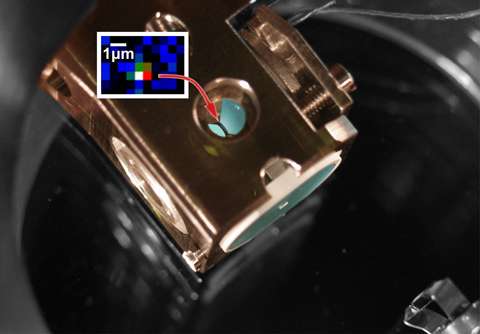A quantum logic gate between light and matter

Scientists at Max Planck Institute of Quantum Optics, Garching, Germany, successfully process quantum information with a system comprising an optical photon and a trapped atom.
When it comes to recognizing complex patterns or to decoding encrypted messages, conventional computers reach their limits. A whole new quality in the communication and processing of data is expected from a technology that exploits the special properties of quantum particles such as superposition and entanglement. Scientists around the world pursue a variety of different concepts towards the development of such a quantum computer. Prof. Gerhard Rempe, Director at the MPQ and head of the Quantum Dynamics Division, follows the strategy of combining two rather dissimilar techniques: quantum communication using photons, and information processing using stationary atoms. His team has now for the first time realized a quantum logic gate between a single photon and a single atom. The development of this hybrid device could be a milestone on the path to a scalable and universal quantum computer.
Any modern computer operates according to a mathematical principle that was developed by German polymath Gottfried Wilhelm Leibniz more than 300 years ago: information can be encoded in the binary system and processed via the application of logic operators. Logic gates are based on this principle. They deterministically generate output signals for any combination of input signals according to a so-called truth table. Nowadays, computers contain many millions of logic gates in the form of electronic circuits.
In the experiment described here, the binary states 0 and 1 are represented by the two spin orientations of an atom (upwards or downwards), and by two polarization states of an optical photon (left or right circular), respectively. In contrast to classical bits, these "quantum bits" can be in a coherent superposition of both states. In order to realize a quantum gate, the atom is trapped inside a cavity which is made of two high-finesse mirrors. The properties of the cavity are chosen in such a way that atom and cavity form a strongly coupled system. The light quanta are prepared as faint laser pulses containing less than one photon on average.
In a former experiment it has been shown that – by a proper choice of parameters – the light quanta are always reflected. What matters is the fact that for certain combinations of atomic and photonic input states the photons are reflected at the first mirror. For other combinations, however, they first enter the cavity, subsequently leaving it on the same path. Thereby, they experience a phase shift of 180 degrees. "This conditional phase shift is the prerequisite for the implementation of a truth table assigning output signals to any combination of input bits in a deterministic way, similar to a classical logic gate.", Dr. Stephan Ritter explains.
"In our experiment we measure both the polarization of the reflected photons and the spin orientation of the atom after the gate operation. At present, we achieve an efficiency of about 70%. By further improving the mirror parameters this value could be significantly improved", Andreas Reiserer says.
These measurements demonstrate that the hybrid atom-photon system can act as a classical logic gate. However, the true advantage of a quantum gate compared to a classical one is its ability to generate entangled states from separable input states. In order to test this specific behaviour, the scientists chose a combination of input bits that – according to the rules of quantum mechanics – must lead to an entangled state of atom and photon after the gate operation. Also in this case the gate mechanism worked as expected.
By successively sending two laser pulses onto the system the physicists could even achieve entanglement between the atom and two photons. By clever manipulation of the atom in a second step it was disentangled, leaving a pair of two entangled photons. "These measurements demonstrate the versatility of the gate mechanism that even provides an interaction between two photons", Norbert Kalb says. "The mechanism should also allow generating entangled cluster states that consist of the atom and several photons."
The development of this hybrid quantum logic gate could be a big step towards a universal quantum computer. "Quantum communication, using flying photons, and data processing with atoms or ions have been regarded as separate research fields so far", Prof. Gerhard Rempe says. "In our experiment we merge both techniques. In particular, our quantum gate could be easily implemented in a network in which atoms serve as stationary nodes for the storage of information, whereas photons transmit the information between these nodes, even over large distances. In this way we hope to contribute to the realization of a scalable quantum computer."
More information: Andreas Reiserer, Norbert Kalb, Gerhard Rempe, and Stephan Ritter. "A quantum gate between a flying optical photon and a single trapped atom." Nature, DOI: 10.1038/nature13177, 10 April 2014
Related story: New 'switch' could power quantum computing
Journal information: Nature
Provided by Max Planck Society


















